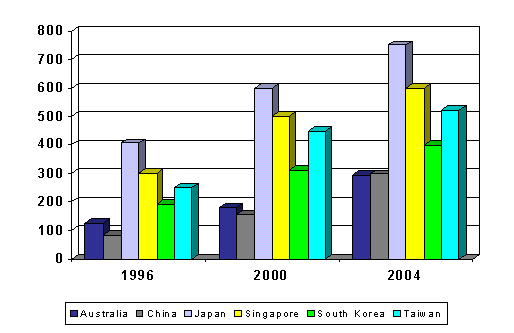|
The
Japanese government had allocated $530 million to the Millennium Project
for biotech for the period April 2000 to March 2001. This project is a
joint industry-government-academia effort to promote new industries with a
total allocation of almost $ 1 billion. Biotechnology accounts for more
than half of the budget, and will be focusing on discovering new therapies
for diseases that are characteristic of senior citizens such as dementia,
cancer, diabetes and hypertension. Besides new therapies resulting from
human genome research, Japanese pharmaceutical companies such as Daiichi
Pharmaceuticals, Fuso Pharmaceutical Industries and Tanabe Seiyaku have
begun to focus on regenerative therapies. 20 to 30 large Japanese
pharmaceutical companies will jointly invest around $4.1 billion and work
together in an effort to speed up the development of gene therapy in
Japan.
India's
Department of Biotechnology plans to spend $65 million on genomic research
over the next five years, bringing five-year forecasts for the country's
spending to $85 million. The funds will be distributed among 15 to 20
research teams in government centers and universities across the country.
Major research areas under this project will include pharmacogenomics,
structural genomics and proteomics. Since the mid-1980s, India has
invested over $300 million in biotechnology, creating a good research
infrastructure.
The
Korean government is also strongly encouraging drug development, and is
encouraging local authorities to establish science parks. The Korea
Biotechnology Industrialization Center is scheduled to be completed in
2002 in Inchon Songdo TechnoPark. It is approved by US FDA to support
adoption of Good Manufacturing Practices (GMP) and will help meet the need
for a pilot plant facility. There are currently 300 new drugs under
development in Korea, with 23 in progress or completion of clinical tests.
Korea expects to reap revenues of US$10 billion in 2010 from biotechnology
products in various sectors.
Figure
5 shows the investment that has been made by governments in biotechnology
since 1996, as well as forecasted investment in 2004.

Market
segments of the millennium
The
key market segments to look out for in Asia would be:
Cardiovascular
drugs: Asia had a stroke
mortality of 4.8 million cases in 2000, which represents 80 percent of the
world mortality. 3.2 million cases were from China alone. For coronary
heart disease, the mortality rate in 2000 was 1 million cases. Coupled
with the increasing incidence of hypertension and hyperlipidemia,
cardiovascular drugs have strong potential for growth in this market.
Additionally the medical device market for stents, catheters and
pacemakers is also forecasted to grow.
Lifestyle
drugs: The increasingly affluent and health conscious Asian society is
expected to boost the market for vitamins, weight reduction supplements
and dietary supplements. Other treatments would be those for hair loss.
Oncology drugs: Cancer is
one of the killer diseases and Asia has 24 percent of world cases of
cancer. Leading types of cancer are lung and stomach cancer. This comes as
no surprise considering that 70 percent of the world population of smokers
is in Asia. In 2000, there were 3.8 million new cases of cancer, 1.7
million of which were in China, followed by India at 0.75 million and
Japan at 0.5 million. Oncology drugs and surgical procedures should see
major breakthroughs in terms of new types of medication and this will also
expand the market. Additionally, the growing aging population in Asia is
expected to increase incidences of arthritis, diabetes, osteoporosis and
certain CNS disorders.
Healthcare
companies would do well to include Asia in their marketing plans for the
future or they stand to lose out on the fastest growing market in the
world.
For
More Information, please contact jgovan@frost.com
|